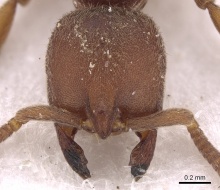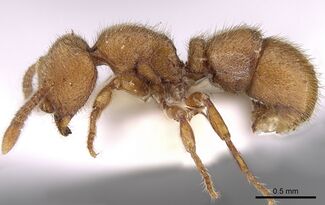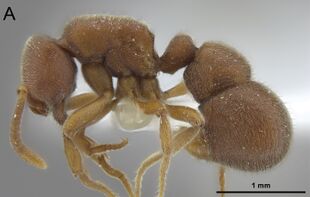Key to Chinese Proceratium
Xu (2006) published a key that is now obsolete. It can be found here: Key to Proceratium of China.
You may also be interested in
1
- In profile, petiolar node squamiform and rectangular, high and erect (Fig. 1A) . . . . . 2
- In profile, petiolar node never squamiform, either low, elongate, and barrel-shaped, or rounded-triangular (Fig. 1B) . . . . . 3
2
return to couplet #1
- In profile, petiolar node clearly narrowing dorsally, broader on the base than on the apex (Fig. 2A and 3D model); in dorsal view, petiole at least 1.5× wider than long (DPeI ≥155); abundant long appressed shaggy hairs from LT3 project distinctly over the constriction between LT3 and LT4 (Fig. 2A) [China: Hunan, Yunnan, Zhejiang; Vietnam] . . . . . Proceratium longigaster
- In profile, petiolar node not or only weakly narrowing dorsally, the base as or almost as broad as the apex (Fig. 2B and 3D model); even if narrowing, petiole never 1.5× times wider than long in dorsal view (DPeI <150); no shaggy hairs protruding from LT3 over the constriction to LT4, if single longer hairs present, then not shaggy (Fig. 2B, also see 3D model in caste section of species page) [China: Yunnan; Taiwan; Japan] . . . . . Proceratium japonicum
 Figure 2. Petiole, abdominal segment III and anterior portion of abdominal segment IV in profile view. A Proceratium longigaster (CASENT0790673) B Proceratium japonicum (CASENT0790834). |
3
return to couplet #1
- Anterior clypeal margin with a distinct and broad notch (Fig. 3A and 3D model); posterodorsal corners of propodeum armed with conspicuous thick and acute teeth (Fig. 3C); head, mesosoma, petiole, and abdominal segment III strongly foveolate (Fig. 22) [China: Yunnan] . . . . . Proceratium shohei
- Anterior clypeal margin without a distinct and broad notch (Fig. 3B); posterodorsal corner of propodeum bluntly rounded or angular (Fig. 3D), never with conspicuous teeth as above; head, dorsal mesosoma, petiole, and abdominal segment III usually granulate or punctate (Figs 8, 10, 12, 14, 15) . . . . . 4
 Figure 3. Anterior portion of cephalic dorsum, in full-face view (A, B), and propodeum and petiole, in profile view (C, D). A, C Proceratium shohei (CASENT0717686) B, D Proceratium itoi (OKENT0016142). |
4
return to couplet #3
- Frontal carinae weakly developed, short, little diverging above antennal insertions, and with narrow lateral lamellae; dorsal surface of body without erect hairs protruding from dense pubescence (Fig. 4A and 3D model); smaller species (WL ≤0.80) with shorter legs (MFeI <80, MTiI <65, MBaI <40) [China: Yunnan] . . . . . Proceratium zhaoi
- Frontal carinae better developed, long, diverging above antennal insertions, and usually with broad lateral lamellae; dorsal surface of body with erect hairs protruding from dense pubescence (Fig. 4B); larger species (WL >0.95) with longer legs (MFeI >80, MTiI >65, MBaI >50) . . . . . 5
 Figure 4. Mesosoma dorsum in profile view. A Proceratium zhaoi (CASENT0790671) B Proceratium bruelheidei (CASENT0790023). |
5
return to couplet #4
- In profile, posterodorsal corners of propodeum rounded (Fig. 5A and 3D model) [China: Hunan, Zhejiang; Taiwan; Japan; South Korea; Vietnam] . . . . . Proceratium itoi
 Head of Proceratium itoi worker |
 Lateral view of Proceratium itoi worker |
- In profile, posterodorsal corners of propodeum angular (Fig. 5B) . . . . . 6
 Figure 5. Propodeum and petiole in profile. A Proceratium itoi (OKENT0016142) B Proceratium kepingmai (CASENT0790031). |
6
return to couplet #4
- Scapes without erect hairs protruding from the dense pubescence; frontal carinae touching each other at their anteriormost level (Fig. 6A), their lateral lamellae relatively narrow, not conspicuously broader above antennal insertions; head (CI 85) and scapes (SI 68) relatively long [China: Yunnan] . . . . . Proceratium longmenense
- Scapes with many erect hairs protruding from the dense pubescence; frontal carinae clearly separated at their anteriormost level, not touching each other, their lamellae broad, conspicuously extending laterally above antennal insertions (Fig. 6B); head relatively broad (CI ≥89) and scapes (SI ≤63) relatively short . . . . . 7
 Figure 6. Anterior portion of cephalic dorsum in full-face view. A Proceratium longmenense B Proceratium bruelheidei (CASENT0790023). |
7
return to couplet #4
- Propodeal declivity punctured, mostly opaque; frontal furrow conspicuous and darker than anterior cephalic dorsum (Fig. 7A and 3D model); posterior face of petiolar node in profile steeper than anterior face and about half as long as anterior face (Fig. 7C) [China: Jiangxi, Zhejiang] . . . . . Proceratium kepingmai
- Propodeal declivity very shiny, at most superficially punctured; frontal furrow inconspicuous and of same color than anterior cephalic dorsum (Fig. 7B and 3D model); posterior face of petiolar node in profile as steep as anterior face and less than half as long as anterior face (Fig. 7D) [China: Jiangxi, Zhejiang] . . . . . Proceratium bruelheidei
 Figure 7. Anterior portion of cephalic dorsum in full-face view (A, B) and petiole in profile (C, D). A, C Proceratium kepingmai (CASENT0790031) B, D Proceratium bruelheidei(CASENT0790023). |














